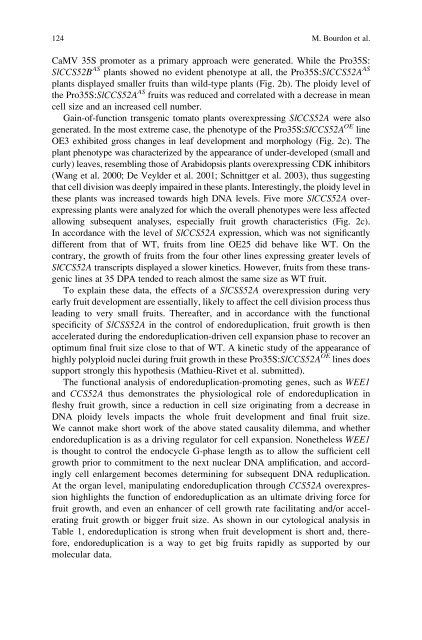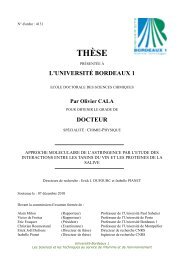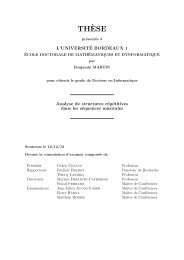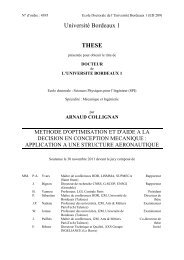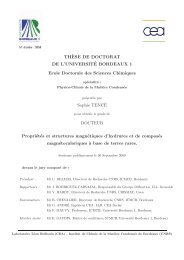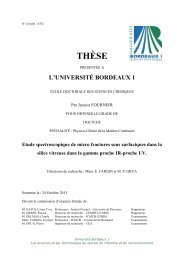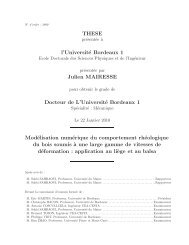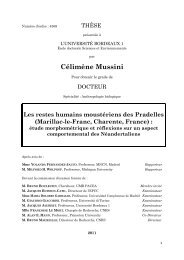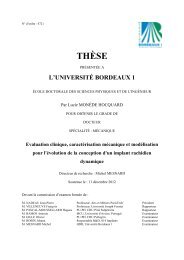de la structure à la croissance cellulaire - Université Bordeaux 1
de la structure à la croissance cellulaire - Université Bordeaux 1
de la structure à la croissance cellulaire - Université Bordeaux 1
Create successful ePaper yourself
Turn your PDF publications into a flip-book with our unique Google optimized e-Paper software.
124 M. Bourdon et al.<br />
CaMV 35S promoter as a primary approach were generated. While the Pro35S:<br />
SlCCS52B AS p<strong>la</strong>nts showed no evi<strong>de</strong>nt phenotype at all, the Pro35S:SlCCS52A AS<br />
p<strong>la</strong>nts disp<strong>la</strong>yed smaller fruits than wild-type p<strong>la</strong>nts (Fig. 2b). The ploidy level of<br />
the Pro35S:SlCCS52A AS fruits was reduced and corre<strong>la</strong>ted with a <strong>de</strong>crease in mean<br />
cell size and an increased cell number.<br />
Gain-of-function transgenic tomato p<strong>la</strong>nts overexpressing SlCCS52A were also<br />
generated. In the most extreme case, the phenotype of the Pro35S:SlCCS52A OE line<br />
OE3 exhibited gross changes in leaf <strong>de</strong>velopment and morphology (Fig. 2c). The<br />
p<strong>la</strong>nt phenotype was characterized by the appearance of un<strong>de</strong>r-<strong>de</strong>veloped (small and<br />
curly) leaves, resembling those of Arabidopsis p<strong>la</strong>nts overexpressing CDK inhibitors<br />
(Wang et al. 2000; De Veyl<strong>de</strong>r et al. 2001; Schnittger et al. 2003), thus suggesting<br />
that cell division was <strong>de</strong>eply impaired in these p<strong>la</strong>nts. Interestingly, the ploidy level in<br />
these p<strong>la</strong>nts was increased towards high DNA levels. Five more SlCCS52A overexpressing<br />
p<strong>la</strong>nts were analyzed for which the overall phenotypes were less affected<br />
allowing subsequent analyses, especially fruit growth characteristics (Fig. 2c).<br />
In accordance with the level of SlCCS52A expression, which was not significantly<br />
different from that of WT, fruits from line OE25 did behave like WT. On the<br />
contrary, the growth of fruits from the four other lines expressing greater levels of<br />
SlCCS52A transcripts disp<strong>la</strong>yed a slower kinetics. However, fruits from these transgenic<br />
lines at 35 DPA ten<strong>de</strong>d to reach almost the same size as WT fruit.<br />
To exp<strong>la</strong>in these data, the effects of a SlCSS52A overexpression during very<br />
early fruit <strong>de</strong>velopment are essentially, likely to affect the cell division process thus<br />
leading to very small fruits. Thereafter, and in accordance with the functional<br />
specificity of SlCSS52A in the control of endoreduplication, fruit growth is then<br />
accelerated during the endoreduplication-driven cell expansion phase to recover an<br />
optimum final fruit size close to that of WT. A kinetic study of the appearance of<br />
highly polyploid nuclei during fruit growth in these Pro35S:SlCCS52A OE lines does<br />
support strongly this hypothesis (Mathieu-Rivet et al. submitted).<br />
The functional analysis of endoreduplication-promoting genes, such as WEE1<br />
and CCS52A thus <strong>de</strong>monstrates the physiological role of endoreduplication in<br />
fleshy fruit growth, since a reduction in cell size originating from a <strong>de</strong>crease in<br />
DNA ploidy levels impacts the whole fruit <strong>de</strong>velopment and final fruit size.<br />
We cannot make short work of the above stated causality dilemma, and whether<br />
endoreduplication is as a driving regu<strong>la</strong>tor for cell expansion. Nonetheless WEE1<br />
is thought to control the endocycle G-phase length as to allow the sufficient cell<br />
growth prior to commitment to the next nuclear DNA amplification, and accordingly<br />
cell en<strong>la</strong>rgement becomes <strong>de</strong>termining for subsequent DNA reduplication.<br />
At the organ level, manipu<strong>la</strong>ting endoreduplication through CCS52A overexpression<br />
highlights the function of endoreduplication as an ultimate driving force for<br />
fruit growth, and even an enhancer of cell growth rate facilitating and/or accelerating<br />
fruit growth or bigger fruit size. As shown in our cytological analysis in<br />
Table 1, endoreduplication is strong when fruit <strong>de</strong>velopment is short and, therefore,<br />
endoreduplication is a way to get big fruits rapidly as supported by our<br />
molecu<strong>la</strong>r data.


